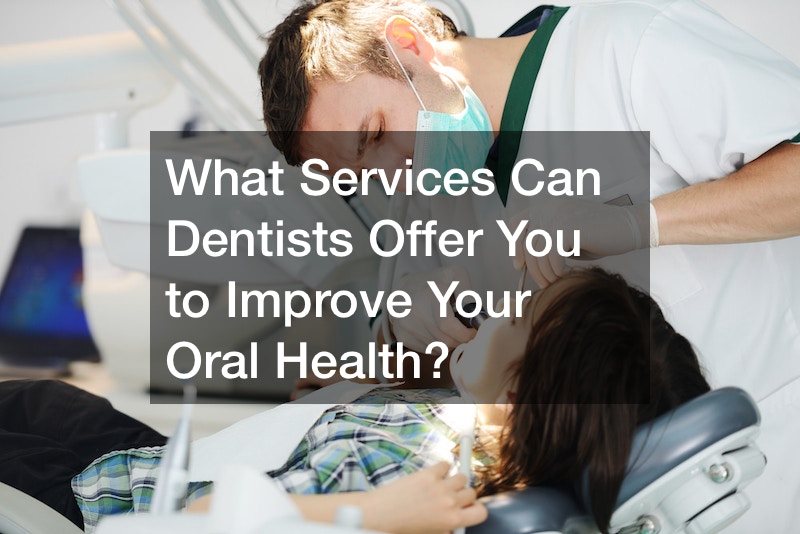Disclaimer: Life Cover Guide. This site provides family & home content for informational purposes only.
For many people, a trip to the dentist is everything from an uncomfortable chore to a terrifying panic attack waiting to happen. But imagine for a moment what life would be like if there were no dentists. The everyday things we take for granted would fall away, leaving us with significant issues. Dentists play a vital role in helping our lives run smoothly.
They give us confidence, relieve pain, and ensure we can speak properly and eat seamlessly. While a dentist may not be your favorite person, we can’t deny that they help us all at one time or another. If you’re looking for dental work, dentists taking new patients typically offer a wide range of services. If you’re not sure what dentists do, then this blog will cover the most common services that can improve your oral health.
1. General Services
The most common service dentists provide is general exams. Dentists taking new patients into their practice will usually give an initial exam. This will include a thorough inspection of the gums, palate, neck, and head to check for abnormalities. During a general exam, X-rays will also be taken to check for more detailed issues like cavities and root damage.
Cleanings are another general service dentists provide. This will include the scraping of plaque and tartar and polishing. Filling of cavities and root canals are other common procedures performed in a general dental practice. Other responsibilities of a dentist include education and instruction in proper oral hygiene. If it’s found that there are more complex oral problems, then general dentists will refer you to a specialist like an oral surgeon.
2. Veneers
Veneers are thin porcelain shells that the dentist will use cement to adhere to existing teeth. This is one of the most common cosmetic procedures that dentists taking new patients perform. This elective service is a good choice for people who are dealing with various forms of tooth damage, discolored teeth, or gaps. It’s non-invasive and involves very little discomfort.
The dentist will need to file off a bit of enamel from the existing teeth to properly fit the veneers. The result is not only a bright and even smile, but a reduction in tooth sensitivity. Many people choose veneers because it’s a more affordable dental care option than other procedures.
3. Invisalign
Invisalign is a tooth straightening system that uses a series of plastic trays to fix abnormalities like spaces, overbites, and crooked and crowded teeth. Unlike traditional metal braces, you can be fitted for Invisalign at your local dental office. People often opt for this product because they are more discreet and more accessible to deal with than regular braces. The straighteners are made from transparent plastic and have no metal wires, so they aren’t easily seen.
You can take them out to eat, drink, and brush. Many people like them because there are no restrictions on what you can eat like with metal braces. The plastic trays are much less uncomfortable than traditional braces, but you do need to keep Invisaligns in all day and night to achieve the maximum benefits.
The main issue with this dental procedure is that patients have to return to the dentist every few weeks to be fitted for new trays. But the process is quick and painless. Most users report having to use the plastic tooth adjusters for anywhere from six months to a year. Dentists taking new patients for this service will explain everything needed and devise individual plans on a case-by-case basis.
4. Braces
Typically made from metal or porcelain, braces are usually not a service you can get at a local dentist’s office. In order to be fitted for braces you must go to an orthodontist. Like Invisalign, the primary purpose of braces is to straighten out teeth. However, braces will also be used to remedy misaligned jaws, palate issues, and more severe teeth issues that other types of straighteners cannot solve.
When getting fitted for braces the doctor will conduct a thorough exam, with panoramic X-rays to see the extent of the issue. Then they will design a custom plan to remedy the problem. On the day of the fitting, patients will first get a good cleaning. Then the orthodontist will apply dental cement to the teeth and adhere the brackets on each tooth, along with metal wiring and elastic bands.
The process only takes about 15 minutes, but patients will need to return about once a month for adjustments and check-ups. There is moderate pain when the braces are first fitted, but some ibuprofen and ice usually take care of it. Depending on the severity of the dental issue, braces may need to be worn from as little as six months to as long as four years.
5. Teeth Whitening
Dentists taking new patients will often go over their services and most times that includes teeth whitening. This is a strictly cosmetic procedure that gives people a brighter, more polished smile. When looking around for the best cosmetic dentist for teeth whitening it’s best to ask people that have had it done. While at-home whitening kits are known to show results, having teeth professionally whitened shows stronger results in less time.
At an appointment like this, the dentist will examine your teeth, and discuss your habits, like smoking and coffee consumption, to determine the best type of treatment plan. When your session starts, you can expect to have a lip retractor put in place to keep your mouth open. Then a thin plastic lining will be put around your inner cheeks and palate to protect from burning. Finally, the dentist will brush a gel made from hydrogen peroxide onto your teeth.
You’ll sit under a laser light for 20 minutes. The process will be repeated two or three more times depending on your individual needs. While getting your teeth whitened doesn’t hurt physically, you will need to stay away from a lot of food and drinks if you want to keep your bright smile. You’ll want to steer clear of coffee, tea, berries, sauce, red wine, and anything acidic.
6. Dental Implants
The decision to get dental implants is a serious one, as it’s a form of oral surgery. Though complications are rare, infection and rejection of the implants are a possibility. Dentists taking new patients may suggest this procedure as an alternative to dentures. It’s a permanent solution when a patient is missing several teeth or is suffering from advanced tooth decay.
Implants tend to be more comfortable than dentures as there’s no slipping or movement involved. People with implants are able to eat and brush normally. When properly cared for implants can last as long as 30 years.
Implants involve inserting a screw-like rod into the jaw bone that has a porcelain crown attached that will be seen at the jawline. Most patients don’t need to be put under general anesthesia for the implant procedure. Dentists use sedation and local anesthesia to ensure patients are comfortable.
Surprisingly, this invasive service is not as painful as you may think. Most patients state that the major pain subsides after 24 hours. There will be some pain and discomfort for about two weeks as the mouth adjusts to its new equipment.
7. Dental Crowns
Some patients will seek out dentists taking new patients to obtain dental crowns. Also known as caps, these porcelain creations cover an existing tooth that has become weak, worn, or too decayed to benefit from a filling. When getting a crown the dentist will take a mold of the tooth to have a proper crown fitted. They will then file down the existing tooth enamel, apply dental cement, and place the crown.
Often, a temporary crown is put in place while the permanent one is being made. A crown is usually a more affordable option than veneers and can last many years when properly cared for. It’s recommended that you avoid sticky foods like gum when you have crowns. Getting a crown is painless and often doesn’t even require local anesthesia. You may experience some sensitivity or slight discomfort for a few days as you adjust to your new crown.
8. Dental Bonding
Dental bonding is the most popular cosmetic procedure dentists perform. This is due largely to the low cost, speediness of the process, and the fact that there’s no pain involved. Bonding is used when teeth are chipped, have gaps, are discolored, or are misshapen. Dentists taking new patients are often asked what they can do to help improve the look of their patient’s smiles.
Bonding is the answer for many, especially if it involves only a few teeth. There’s also very little filing of the enamel so the procedure is completely reversible. It’s a simple way to close up flaps and make teeth appear longer. During the bonding process, the dentist will use the same resin material used to fill cavities.
Bonding is non-invasive so it won’t cause any pain. However, you may have some sensitivity for a few days after the procedure. The entire service will take only 30-60 minutes.
It will involve choosing a shade to match your natural shade, a bit of filing, and the application of conditioning liquids. After that, the dentist will apply the resin and shape it. After allowing the resin to cure under a heated lamp, the dentist will polish the bonding, and you’ll be on your way.
9. Pediatric Services
Finding a good pediatric dentist taking new patients is vital when you have children. There can be a lot of fear and anxiety for a child going to the dentist for the first time. Dentists who specialize in working with kids are required to do at least a 2-year residency in pediatric dentistry. So they are comfortable and knowledgeable about the unique challenges working with kids can bring.
A pediatric dentist provides the same services as a general dentist but focuses on the prevention of tooth decay. They should also have a welcoming office and a warm fun-loving personality. It’s recommended that children have their first dental check-up before they are a year old.
A typical dental exam for a child will include X-rays, a cleaning, fluoride treatment, instruction on proper brushing and flossing, and education on nutrition and supplements. If necessary a pediatric dentist will fill cavities, remove extra baby teeth, and provide early orthodontic care like retainers. They can also work with parents on breaking habits like thumb-sucking and pacifier use.
10. Emergency Services
Like all other unexpected issues dental emergencies can happen out of the blue. So it’s important to find a local dentist office taking new patients that’s also an emergency dentist. You never know when the unbearable pain of a toothache may pop up or a tooth suddenly gets chipped.
An emergency dentist is one who is capable of treating an oral emergency and allows walk-ins or the ability to quickly make an appointment. Many dentists keep blocks of time open for emergency appointments to care for patients in immediate need. Other dire situations a dentist can treat are tooth and gum infections, abscesses, cracks, loose fillings, and a tooth that has been knocked out.
If you suddenly find yourself with a tooth that’s fallen out, try to reinsert it back into the socket. If that doesn’t work place it under your tongue and hold it there while you get yourself to the dentist. Some dentists will also see you if you think you’ve broken a bone in your jaw. This is a good option over sitting in the emergency room for hours. Depending on the severity, they may send you anyway, but it’s worth a try.
Final Thoughts
As you can see dentists provide a wide variety of important services. The procedures they perform can do everything from relieving pain and discomfort to giving confidence and making eating easier. When choosing a professional make sure it’s a dentist taking new patients, they take your insurance, and you and your family are comfortable with them.










